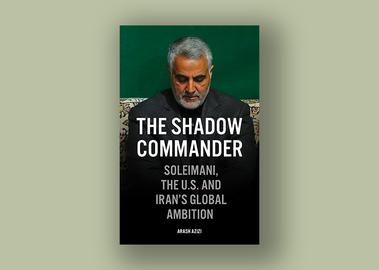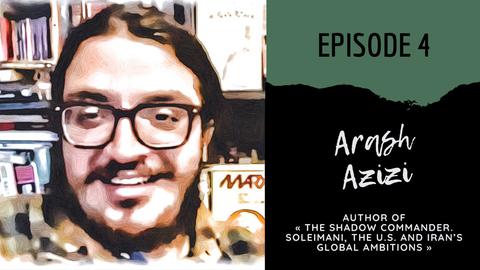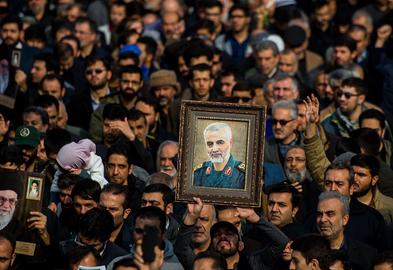As Iraqi protesters marked the one-year anniversary of the assassination of Iranian Revolutionary Guards’ Quds Force commander Ghasem Soleimani on January 3, they called for an end to United States’ presence in the country, many of them holding up banners with Soleimani’s photograph plastered across them. A year on, what can Soleimani’s death tell us about relations between the US, Iraq and Iran?
Many observers of the Islamic Republic of Iran's relationship with the United States regard the first direct talks between the two countries to be centered on the issue of Iran’s nuclear program, led on the Iranian side by Mohammad Javad Zarif, Iran’s foreign minister. However, in some ways, the first public and face-to-face contact between the two countries is actually linked to Ghasem Soleimani.
In his new book The Shadow Commander: Soleimani, the US,and Iran's Global Ambitions, Arash Azizi argues that the assassination of Ghasem Soleimani, a Guards major general and, from 1998, leader of its Quds Force, posed the most serious and real threat of armed conflict between Iran and the United States in the last decade.
The author begins his narrative on the evening of January 2, 2020 New York time, when a new day was dawning in the Middle East. Overnight in the United States, rumors begun to circulate on social media about a drone strike on a convoy of US military opponents in Iraq, which included a senior military man of the Islamic Republic.
Hours later, these initial rumors were confirmed: "Pictures were published of his severed arm, his digitus medicinalis adorned with a signature amulet ring. Soleimani was gone.”
The 63-year-old commander, who survived the eight-year war with Iraq, was killed in a US airstrike on the outskirts of Baghdad along with nine others, including Abu Mahdi al-Muhandis, the commander of a militant group Soleimani set up in Iraq.
Soleimani: From Kerman to Afghanistan and Iraq
No one could have predicted that a one-time simple employee of the Kerman Water and Sewerage Department would one day push Iran and the United States to the brink of a full-blown military confrontation.
Soleimani returned to Iraq after the fall of Saddam Hussein, who was toppled by the United States in 2003, 15 years after the end of the Iran-Iraq war.
The US military under George W. Bush, president at the time, defeated the Ba'athist regime in Iraq in early 2003 with astonishing speed, fulfilling the dream of the founder of the Islamic Republic, Ayatollah Ruhollah Khomeini, who had hoped for such a victory during Ali Khamenei’s presidency of Iran (1981-1989). Soleimani, who was the commander of the army division of Kerman during the war with Iraq, went to Iraq this time as the commander of the Quds Force, the branch of the Revolutionary Guards that runs foreign operations, to seize the golden opportunity created by the United States to establish militias similar to Hezbollah in Lebanon and to dominate a country that had previously posed the most serious security threat to the Islamic Republic.
While Bush threatened the Islamic Republic with a military offensive, having previously labeled the country as being part of the "axis of evil" along with Iraq and North Korea, there were fears among Iranian officials that Iran would be next in line after Afghanistan and Iraq. The Islamic Republic's reciprocal threat was that Iraq would become a quagmire of US military forces, grounding the United States in Iran's neighborhood.
The most important mission of the Revolutionary Guards’ Quds Force was underway.
Soleimani had previously mobilized Afghan forces to work with the United States to defeat the Taliban in Afghanistan. Azizi’s book describes how, during the ongoing negotiations between the Islamic Republic and the United States regarding Afghanistan, Iranian diplomat Mohammad Mehdi Taherianfard made it clear to the Americans that the talks, although approved by the government of Mohammad Khatami (Khatami was president between 1997 and 2005), would not involve Iran’s Ministry of Foreign Affairs, but instead be lead by a person whose name was unknown to Americans up to that point: Ghasem Soleimani.
Soleimani traveled to Tajikistan to meet with Afghan anti-Taliban commanders to announce the Islamic Republic's commitment to working with the United States to eliminate the Taliban. On a series of regional trips, he assured Central Asian countries of Iran's support for an independent post-Taliban Afghanistan. In this way, an exceptional project of cooperation took place between Iran and the United States, facilitated by the Revolutionary Guards.
Azizi writes: “It was Mohammad Javad Zarif’s theatrical role in the Bonn conference that made media headlines (and the history books) but it was Soleimani who had helped gain the trust of Afghan militias, not in a meeting room in a European hotel in 2001 but in a Kabul surrounded by Taliban in 1996 and in battlefield valleys and gorges of the north” prior to the US invasion of Afghanistan. Zarif was the Permanent Representative of the Islamic Republic to the United Nations at the time.
Talks to Prevent Iran From Being Next US Target
Although cooperation between Iran and the United States in Afghanistan was more satisfactory for the Islamic Republic, the situation with Iraq was fraught with concern that if the United States were to succeed fully in that country, it might consider Iran as its next target in the "axis of evil”. Soleimani pursued the policy of forming Shia militant groups in Iraq that would disturb the American forces’ activities. But according to The Shadow Commander, he was the one who had direct talks with the US Ambassador to Iraq, Ryan Crocker, in May 2006. He was accompanied by US General David Petraeus, commander of the Multinational Force in Iraq.
When it comes to US-Iranian historical negotiations during Ayatollah Khamenei’s time as Supreme Leader, the public will automatically think of the nuclear talks with Zarif at the helm. But in reality, face-to-face contact and discussion between the two countries dates back to Ghasem Soleimani in Iraq.
The subject of negotiations in the spring of 2006 focused on the election of the next Prime Minister of Iraq. Previously, the Islamic Republic was worried about Saddam's unpredictable and dangerous conduct. Now it was part of a decision-making process, along with the Americans, to appoint a prime minister in Iraq — a situation that had been unimaginable for the Islamic Republic before the US invasion of Iraq. A decade later, with the emergence of the Islamic State (ISIS) and the official military presence of the Islamic Republic of Iran in Iraq, the Revolutionary Guards’ control over the political affairs of Iraq and, of course Syria, intensified.
Soleimani, who traveled to Moscow to meet with Russian leader Vladimir Putin despite United Nations Security Council travel sanctions, persuaded Putin to work with the Islamic Republic to launch an operation against ISIS and to support the Syrian President Bashar al-Assad. Russia's extensive military presence in Syria helped Soleimani advance his goals in another Middle Eastern country.
In The Shadow Commander, Azizi examines the Islamic Republic's efforts to find an ally in the Arabian Peninsula. These efforts, he says, resulted in its alliance with and support for the Houthis' Ansarollah group in Yemen, including supplying the militia with arms, although Iran’s presence in the peninsula is not as widespread as it is in Iraq, Syria, and Lebanon. This was a new and unprecedented achievement by Soleimani, so much so that he created an armed force against Saudi Arabia through the Houthis.
Azizi also describes how a Houthi sniper targeted and killed Ali Abdollah Saleh, the former president of Yemen, in Yemen’s capital Sanaa on December 4, 2017 following a direct order from Ghasem Soleimani. Saleh had initially joined Ansarollah during the country's civil war against the president at the time but disagreed with the group later. This assassination helped strengthen the Houthis and maintained the slow and steady influence of the Quds Force in Yemen.
The recapture of ISIS-controlled cities and areas in Iraq and Syria, the finding of a new ally in Yemen, and the proxy confrontation with Saudi Arabia turned Ghasem Soleimani from a shadow commander not very well known even in Iran into an internationally renowned figure of the Islamic Republic in the region at a time when Zarif's popularity was declining inside and outside Iran. As one of Ayatollah Khamenei's most loyal allies, the Islamic Republic imbued him with heroic significance.
A Powerful Man, But a Surprise Assassination
As Soleimani entered his sixties, he was no longer an ordinary employee of the Kerman Water and Sewerage Company. His influence in Iraq was such that he was said to have traveled there without the need for routine and required official coordination and even without the knowledge of the Iraqi prime minister. This situation probably contributed to the nationalist outrage against him in Iraq. During anti-government protests in Iraqi cities in 2019, which included the burning of flags and attacks on Iranian consulates, the image of Soleimani became a negative symbol to many Iraqis, to the point that his opponents in some parts of the country rejoiced after his assassination, some of them distributing sweets in celebration.
For most senior officials in the Islamic Republic, Soleimani's assassination was probably far more unexpected than a military confrontation with the United States. Islamic Republic officials refer to Soleimani as "the hero of the fight against terrorism" and the "main commander" of the liberation of Syria and Iraq from ISIS. He was made into a formidable military symbol, invulnerable even against ISIS. When the US assassinated him, it was a red line for the Islamic Republic. But the truth was, the regime never expected it.
When Iraqi protesters attacked the US embassy in Baghdad in December 2019, they also scrawled the name of Ghasem Soleimani on the wall. At this point, the US may well have decided the situation had veered so out of control it had to take action. It was time to cross the red line Iran had set for the US.
At the same time, Arash Azizi suggests, Soleimani's death could mark the beginning of the end of the Islamic Republic’s influence — led by its shadow commanders —in Iraq.
On the same day of the assassination, Supreme Leader Ayatollah Khamenei appointed Ismail Qaani as the new commander of the extraterritorial Quds Force of the Revolutionary Guards. But he is far from being on the same level as Soleimani. As Azizi points out, Qaani does not speak Arabic as Soleimani did. More importantly, he lacks Soleimani's charisma and connections. Bad luck for him, too, that Mostafa Kazemi has been elected Prime Minister of Iraq, a president determined to curb the Islamic Republic's influence in his country at all costs.
Related coverage:
A Year After his Death, Soleimani's Corrupt Practices Begin to Surface
Who was General Ghasem Soleimani: Murderer or Hero?
Who is Ismail Qaani, the New Commander of the Revolutionary Guards’ Quds Force?
visit the accountability section
In this section of Iran Wire, you can contact the officials and launch your campaign for various problems



























comments